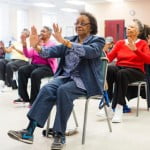Vearlie Segears, 78, takes two buses to get to the Hattie Holmes Senior Wellness Center in the District of Columbia, and the trip is worth it. “I come in the mornings,” she says. “I do open gym – I ride the bike and I walk the treadmill, then I do aerobics. Then I work on the computer.” She often sits in on computer classes and notes, “I’m getting to be a whiz.”
Retired since 1992 from a career in federal agencies, Segears, who lives alone, has been coming to the center for about five years. Depending on the day’s offerings, she might attend a nutrition class or the weekly “Color Me Relaxed” session. But with double knee replacements and implants, Segears doesn’t join in the line dancing. She enjoys lunch in the large Multipurpose Room – the salad bar is her favorite. There’s always someone to talk to. “It’s easy to make friends at the center,” she says.
It’s all free: the state-of-the-art fitness equipment, communal meals and computer classes, and every activity, workout session, health screening and guest speaker featured in the center’s packed monthly calendar.
[Read: Aging Parents at a Distance Who Aren’t Really ‘Just Fine.’]
Engaging Mind, Body and Soul
Located in the District’s Ward 4, Hattie Holmes is one of six senior wellness centers in the city. It opened in 2007 and is supported by the D.C. Office on Aging.
The facility is inviting and attractive, from its central atrium to the surrounding hallway decorated with handmade quilts created in the quilting room, where a large piece, “Underground Railroad Symbols,” by member Barbara Allen has pride of place.
Membership is available to D.C. residents 60 and older. Although there are about 2,000 members on the books, about 120 are active, regular members, says Teresa Moore, director of the center. Staff members include a fitness specialist, nutritionist, health promotion specialist, activities coordinator and an administrative assistant. A computer instructor teaches classes on basics, Microsoft Word and Office, Internet downloads and more in the computer lab.
What Hattie Holmes isn’t: an adult day care center. Members are a self-selected group of autonomous people, Moore says. If she were to notice an older adult being dropped off and spending the stay just sitting alone, Moore says, she would get in touch with the family.
Health is a big focus at the center. Many members are managing chronic conditions such as diabetes and high blood pressure, Moore says. Screenings conducted at Hattie Holmes include blood pressure, glucose, cholesterol, vision, hearing, balance and memory.
Some members “think they work here,” Moore jokes. They arrive first thing in the morning, she says, for fitness, lunch, and with it all, socializing – an important part of the aging process. The seniors are a tight-knit group. For instance, she says, a member who drives will take others to the store or pick up items they need.

Activity and camaraderie at Hattie Holmes Senior Wellness Center in Washington, D.C. (Brett Ziegler for USN&WR)
Referrals can come from case managers at area hospitals, Moore says. Or seniors learn about the center at health fairs or by word-of-mouth. Distant family members can locate centers for their loved ones through the DCOA.
Instead of being at home and not particularly engaged, seniors come to a wellness center for a mind-body-soul continuum, Moore says. “It’s an integral part of their lives – to come to a place where no fee is associated, which is very unique,” she says. “They don’t have to pay, and they’re getting an array of programs, resources and services.”
[Read: Finding Support for Seniors Facing Challenges Living Alone.]
A Place to Be Around People
Sam Jackson, 78, lives close enough to walk to the Hattie Holmes center, using his cane to support arthritic knees. Other times, like today, he feels like driving.
Jackson, a widower with four children in different parts of the county, spends time at the center almost every day. He enjoys using the exercise bike or just sitting and reading or working on crossword puzzles. Coming to the center is “very important,” he says. “It’s someplace to go and be around people and do different things.”
Some activities are just, well, fun. There’s the billiards table and the card room, where games like Phase 10 are all the rage.
Filling Diverse Needs
There are 11,000 senior centers throughout the U.S., according to the National Council on Aging. Different senior centers across the country focus on different goals, depending on the needs of the community, says Susan Getman, executive director of the Wilmington Senior Center in Delaware.
“In … communities such as ours, we’re very concerned about economic security, economic stability of older adults,” Getman says. That means a lot of financial coaching and helping people plan for retirement, access benefits and find housing.
Last year, the Wilmington Senior Center served about 1,400 people, of whom roughly 300 are actually members, Getman says. Along with more traditional services, she says, “We work with and try to support two specific and growing populations. The group of grandparents who are raising their grandchildren and also people who are caregivers for frail elderly or chronically ill adults.”
Senior centers are underutilized, says Getman, who is also chair of the executive committee for the National Institute of Senior Centers, a constituent unit of the NCOA. Part of the reason, she says, is that centers need to better promote themselves and explain to communities who they are.
Despite their variations, senior centers fill certain common purposes. “Whether it’s lifelong learning centers or a place where people can come to find out new ideas, to share their own ideas, to be able to be creative – whether it’s in a visual art or theater or music – people want a place to express themselves,” Getman says.
A personal touch is what sets senior centers apart from other aging-related services, Getman says. “If you talk to the people who come here, they would say it’s a warm and welcoming place,” she says. “A place where they’re treated as individuals and responded to and respected. Where they’re known and can make it their place.”
[Read: Ageism, Attitude and Health.]
Evolving Identity
Senior centers’ roots are usually traced back to a team of New York City social workersaround the late 1950s, says Kathryn Lawler, director of the Area Agency on Aging for the Atlanta Regional Commission. The concern was the “severe and profound” isolation seniors faced despite all the services they received, she says.
“So the concept of bringing folks together, and often, because this is how Americans and probably [all] human beings do, around a meal, was kind of born,” Lawler says. “From there, they have evolved tremendously.”
Greater longevity brings with it new opportunities to be active and healthy and explore all kinds of learning, Lawler says. “Learning new skills – everything from art to languages to current events – all kinds of things. So, just as folks started living so much longer and their needs for enrichment changed, so have senior centers evolved with them.”
This is a period of rapid reinvention for senior centers, she says. One challenge is the term “senior center,” which can be off-putting in a culture in which people don’t want to think of themselves as aging or see themselves as older adults.
“If you just think of a private fitness facility to which people belong, you could look at the average age, and that age is probably below 40,” Lawler points out. “It would be a terrible idea to say, ‘This is the younger-than-40 fitness center,’ even though that might be the truth. Because lots of other people still might want to go there or imagine themselves going there. So you just focus on what the shared goal of everybody who walks through the door is – which is health or fitness.”
The way people understand the concept of isolation is changing, Lawler says, with opportunities to think across generations. For instance, she says, centers could be located near or within school facilities so older people could be after-school tutors. “Or [there could be] co-located senior centers and day care centers so older people who want to can hold babies or help with feeding or even just experience the joy and noises of a playground,” she says. “There certainly are all kinds of new ideas emerging.”
[SOURCE :-usnews]


